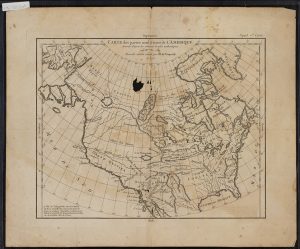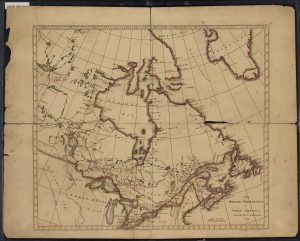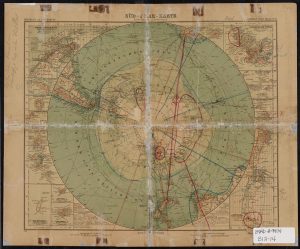This blog post is part of the Frozen Friday Series, an A-Z journey of the Polar Archives. Each week, we will feature some aspect of the history of polar exploration with a blog post written by our student authors. This week, it’s a blast from the past! Last year, Autumn Snellgrove interned at the Byrd Polar and Climate Research Center Archival Program and worked with new materials acquired by the program. In short, she scanned and researched these materials and wrote two blog posts about them. This is one of them.
In June of 1930, the famous explorer Hubert Wilkins, accompanied by Sloan Danenhower found themselves sorting through a Navy scrapyard, examining submarines for a trip under the North Pole. The Navy had given Wilkins his pick of the scrapyard, with the chosen submarine to be leased for only one dollar. The submarine in the best condition was O-13, which also held the record for the deepest dive. The pair, however, were spooked by the number 13, so “letting superstition overcome logic, they settled on the O-12.”[i] Unfortunately, the O-12 would prove as unlucky as they feared 13 would be.
Wilkins proposed a trip into one of the last uncharted places on Earth. He planned to travel by submarine underneath the North Pole from Norway to Alaska. The expedition would be called the Wilkins-Ellsworth Trans-Artic Submarine Expedition. Such a journey was fraught with risks. The Arctic holds no land beneath the ice and is composed of shifting ice floes which occasionally collide and shoot spikes into the ocean. Worse, everything that sailors usually rely on to navigate —the deep basin, the currents, the thickness of the ice, the temperature, its interaction with other oceans—was uncharted in 1930. For Wilkins this was part of the attraction; the ability to aid science, to learn about weather and “to fill in the last unknown on the map”[ii] drove his ambition and excitement for the journey.
Navigation in the uncharted Arctic was not Wilkins’ only obstacle, however. The O-12 itself, rechristened the Nautilus (with ice, as champagne was still illegal), proved to be one of the greatest challenges. The O-class submarines were built for coastal waters, not the Arctic or even, as Wilkins would discover, the open ocean. This meant that the submarine would have to surface every day to recharge its batteries and gain fresh air in a stretch of ocean that was uncharted and plagued with constantly shifting ice floes. If the submarine was unable to find a safe place to surface, the crew only had three days of emergency air before they would suffocate (partially explaining the trip’s nickname of “the suicide club”). These issues were compounded by the number of modifications necessary for the Nautilus, including fixing the engines, finding and caulking all leaks and preparing it for scientific experiments.
In spite of these problems, the newspapers hailed the expedition as ‘The Greatest Adventure in History.’ A flood of individuals applied to join the crew, children gave pennies to help fund the project, and there was a scheduled rendezvous with the Graf Zeppelin when the Nautilus resurfaced in the Pacific. The trip itself, however, was not to fulfill the expectations of its newspaper headlines.
Tragedy befell the expedition even before the submarine departed the U.S. While entering New York, Willard Grimmer, the quartermaster, was swept overboard by battering waves and drowned. This unfortunate accident was not the only disaster, either. During its first deep sea dive, the Nautilus sank and got stuck in the mud at the bottom of Long Island Sound. Though the submarine eventually dislodged itself, this was not the last time that the crew faced death within the Nautilus, as the entire trip to the Artic lay ahead of them.
Only three days into the journey, a storm hit. The Nautilus was not designed for the fury of the open ocean. As a result she pitched and rolled to the point that even Wilkins, the most experienced explorer on board, became seasick. During this expedition, the Nautilus and its crew barely escaped death on several occasions. At one point, water seeped into one of the engines. Left unchecked, the engine would have punched a cylinder through the side of the submarine, sinking the ship. With no lifeboats on board, the sunken sub would have served as a tomb for the entire crew. This crisis was averted due to the quick reflexes of the chief engineer, Ralph Shaw. At another point, with the ship now running on only one engine, the crew nearly suffocated when a wave slammed the tower hatch closed, threatening to create a vacuum in the submarine. Fortunately, everyone on board survived, owing their lives to an open forward ventilator. Then the worst happened: the second engine stopped, stranding the submarine in the middle of the Atlantic Ocean. The crew was without the power to restart the engine or even send a distress signal and they had no fresh air. Given the nature of the submarine and the bad weather, they were also basically invisible to any passing ships. The radio engineer, Ray Meyers, had to cobble together some of his equipment into a make-shift transmitter to send out the SOS signal. Nearly eighteen hours later the U.S.S. Wyoming came to rescue the stranded Nautilus, before towing it to Ireland. Four crew members subsequently quit.
Repair on the submarine, expected to take two weeks, took a month. Ever the optimist, Wilkins hoped all of the misfortunes to date meant that the expedition had already encountered all of its bad luck. This was not to be. Almost immediately upon resuming the trip, the Nautilus was besieged by yet more storms. It became clear that the Nautilus was too unreliable to safely complete the trip.
Yet Wilkins remained determined and decided to submerge in Arctic waters. While the ship was preparing to dive, Commander Danenhower realized that the submarine’s diving planes were gone. Without these planes the submarine could dive under the water, but could not be controlled while submerged. This made the planned journey to Alaska impossible. Wilkins never investigated how or when the planes were lost but he, along with Meyers and a few other crew members, believed the ship was sabotaged by several of the crew members. Given that only the diving planes were lost, while the vertical plane and the propellers were untouched, this rumor of sabotage seems very likely. Floating ice would not have been so selective about the damage it did.
Wilkins, however, would not accept complete defeat. To do so would mean personal and financial ruin. Instead, he decided to continue north. Recognizing the potential scientific opportunities from the beginning, Wilkins had two well-known scientists onboard to run experiments. Aided by the head scientist Harald Sverdrup, Wilkins collected some of the first data about the polar oceans, including mud samples and information about new ocean creatures. Wilkins did manage to force the submarine to dive to 37 feet by flooding part of the submarine and running into the ice, thus proving the possibility of under-ice travel, but the dive paled in comparison to his original plans. Later the expedition would be called “a landmark in science”[iii] but it did not satisfy the donors and readers eagerly awaiting news of Wilkins’ success.
After completing only a few dives, Wilkins was forced to leave the Arctic due to the Nautilus’ continued deterioration and the worsening weather. Wilkins had to face the worst storm upon his return, however, as he met his supporters and critics. Although Wilkins did prove that travel by submarine under the polar ice was possible, his trip was largely perceived as a failure, as people focused on the incomplete trip and not the scientific experiments.
Recently, over one hundred images documenting the Nautilus expedition were acquired by the Ohio State University’s Polar Archives in 2015 and join the larger Wilkins Collection held by the repository. These images span the entire expedition, from Wilkins and his wife Lady Suzanne waving at crowds to images taken from under the ice in the Arctic. Most of the images are of the Nautilus in the Arctic, many likely taken after Wilkins realized that he would be unable to continue the journey as planned. These images tend to depict the Nautilus as it arises from the ocean or as it is banked against the ice.
Other images show the crew, the people who risked their lives to adventure; one is of the chief radio operator Ray Meyers holding his young daughter as she appears to kiss him goodbye; another shows a child sitting on the beds in the submarine; one even shows Wilkins and some of his crew posing for a funny picture, each man clutching their hats and laughing . Some pictures even showcase the very cramped conditions on the submarine, include what looks to be a picture of the dining area where there was so little room, that individuals had to eat standing up.
Perhaps some of the most remarkable of the images are those taken while the Nautilus was submerged under the ice. These pictures are the only ones in color, and they have short captions describing the situation and the ice. While these show little more than a deep blue sea and floating ice, they hint at the mystery and the danger the Nautilus and its crew faced while under the sea.
For more information about Sir George Hubert Wilkins or the Nautilus Expedition, please visit the Polar Archives.
[i] Nasht, Simon. 2005. The last explorer: Hubert Wilkins: Australia’s unknown hero. Sydney: Hodder Australia.pg, 215
[ii] Nasht, Simon. 2005. The last explorer: Hubert Wilkins: Australia’s unknown hero. Sydney: Hodder Australia.pg, 213
[iii] Nasht, Simon. 2005. The last explorer: Hubert Wilkins: Australia’s unknown hero. Sydney: Hodder Australia.pg, 247
Written by Autumn Snellgrove and published by John Hooton















Recent Comments